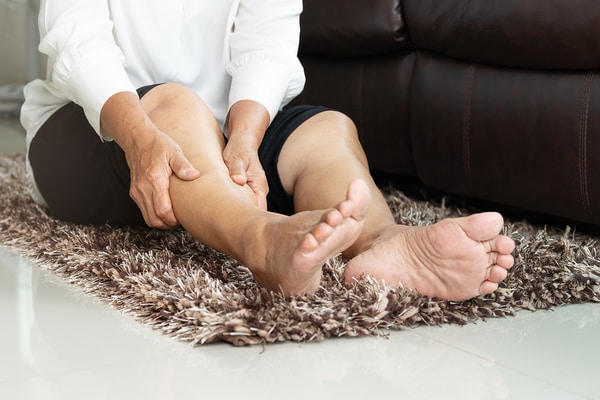The arteries are pipes in your body that carry oxygenated blood from your heart out to all the organs and extremities in your body. The veins are a series of pipes that bring non-oxygenated blood from everywhere in your body back to your heart and lungs to get re-oxygenated. Think of hot and cold pipes – The arteries are red pipes and the veins are blue pipes.
In this section, we will be discussing the arteries in your body. That’s where Peripheral Arterial Disease (PAD) (sometimes referred to as Peripheral Vascular Disease – PVD) will occur.

Peripheral Artery Disease is plaque build up in the arteries. There are several very common arteries that can build up plaque – they are the coronary arteries (in your heart), the arteries in your legs, and the carotid arteries in your neck. PAD is plaque build up in the arteries in your leg. Plaque is the hardening of the arteries due to abnormal buildup of cholesterol. This is also sometimes referred to as Atherosclerosis. As this plaque buildup gets worse, blockages will get worse and compromise the blood flow through the arteries. When a blockage in the arteries form, a series of symptoms will occur. As the blockage gets worse, so too will the symptoms.
PAD can occur in patients of all ages. There are several risk factors that will increase your chances of developing PAD. The two biggest risk factors for developing Peripheral Artery Disease are:
PAD develops undetected in most patients. As the plaque builds up, the symptoms will begin to show. The early stage of PAD can show signs of claudication. Claudication is when the muscles of the leg begin to cramp during walking. As you walk further, the symptoms of cramping will get worse. When you stop and rest, the muscle cramps will go away. When you start walking again, the cramping will return. The distance you walk until the symptoms of claudication develop will vary from patient to patient. Generally speaking, as the blockages get worse, the distance you can walk will get shorter. In the most severe of cases, some people can’t even walk 50 feet before they need to stop and rest.
The most common muscles affected are the calf muscles. However, other muscles that can be affected are the thigh and even buttock muscles. Other symptoms patients may feel are a dull ache, sense of muscle fatigue and even heaviness.
If the blockage is left untreated, it can get worse over time. When the blockage gets worse, a new set of symptoms can occur. There may be pain in the toes or foot even at rest! This is usually noticed when you lay down in bed to go to sleep. The pain in the foot can become unbearable for many patients to where they need to drape the foot over the side of the bed to find relief. Sometimes, they have to get out of bed to stand before they get relief from the pain.
This pain at rest is known as Critical Limb Ischemia or CLI. This represents a very crucial point and immediate medical attention is required! Not addressing these symptoms immediately can cause the tissue on the toes or foot to die – this is Gangrene! If a wound or ulcer forms, you are at serious risk of amputation of the toe or leg. In this scenario, you will be seen in our office on an emergent basis by a Board Certified Vascular Surgeon and will be immediately placed in our Amputation Prevention Program. The details of the Amputation Prevention Program at Coastal Vein and Vascular Specialists will be discussed in a different section.
If you have signs or symptoms of an ulcer, wound, or gangrene on your toe, foot, or leg – please call us immediately! (561) 295-4110
The first test is a thorough physical examination. At Coastal Vein and Vascular Specialists, you will have a Board Certified Vascular Surgeon performing your physical exam. The Vascular Surgeon specializes in diagnosing and treating Peripheral Artery Disease. Your CVVS surgeon will be looking for:
If any of these findings are identified in the physical examination, a simple painless test will be performed by our vascular lab. This is called an Ultrasound. This test will be performed by one of our Certified Registered Vascular Technicians in our office at Coastal Vein and Vascular Specialists. This ultrasound will identify where in your leg the blockage is by looking at the blood vessels and blood flow throughout the entire leg.
Depending on the ultrasound findings, other tests may be required such as Cat Scan (CT) or a Magnetic Resonance Image (MRI).
Coastal Vein and Vascular Specialists primary focus is on all minimally invasive treatments for all the arteries and veins in the body. Almost all patients with PAD are able to be treated by a minimally invasive and out-patient procedure. On very rare circumstances is surgery required.
Your Board Certified Vascular Surgeon will perform a procedure called an Angiogram. This is where the surgeon will use a series of small wires and catheters to cross the blockage. Once the blockage is successfully crossed, a balloon or stent will be used to open the blockage. Many times an atherectomy will also be performed witch is sort of like a roto-rooter to open the blockage before a stent is placed. In other circumstances a laser may be needed to open the blockage prior to a stent being placed. This procedure is not painful and is much better then performing an open operation. The Angiogram may be performed at the hospital or a special out-patient based lab. But in almost all cases, the patient is able to go home the same day.
We will ask that the patient does not perform any strenuous activity or heavy lifting for two days. After which, the patient may return to normal daily activities.